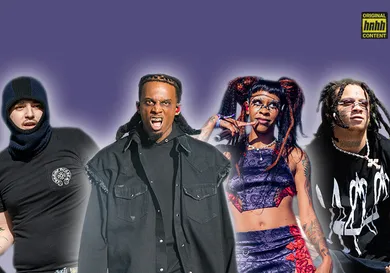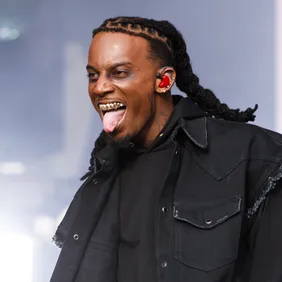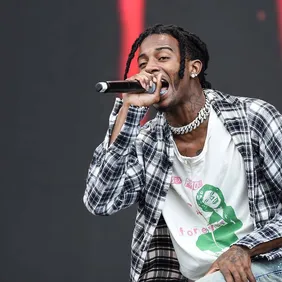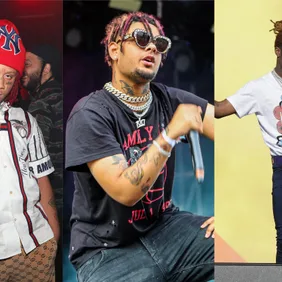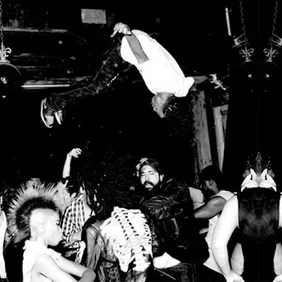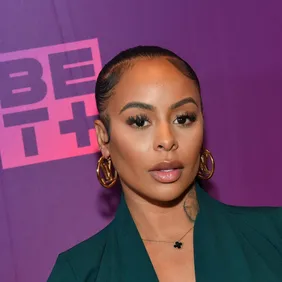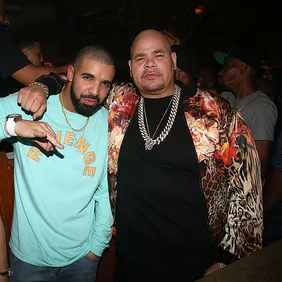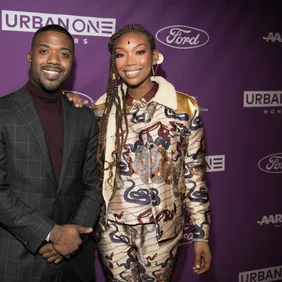The 2020s have had an explosive first few years when it comes to hip-hop and rap. With so many new artists making their dent in both the underground and the mainstream, many fans of the culture have noticed a buzzy synth in their ear, hard-hitting trap beats, and aggressive vocals both steering and dominating the direction of the genre.
Playboi Cardi - Jason Kempin/Getty Images
This sound, generally, is called rage. It’s become popularized by some of the biggest rappers in the world and it’s been pioneered by some of the underground’s most mysterious and raw hip-hop artists. Its roots are embedded in the trap and SoundCloud scene that defined the 2010s, but rage music’s skyrocketing popularity and prolific use hints that it may become the defining sound of the 2020s.
Let’s take a look at how rage music presents itself in hip-hop, which artists have capitalized on it,, and where it might go from here. Sit back, blast some “rage type beats” on YouTube, and get ready to mosh.
What Is Rage?
To put it simply, rage is a subgenre of trap that began gaining momentum in the 2020s. The online music community known as RateYourMusic, who also categorize genres and their relevant releases, says rage is “characterized by dense, repetitive synth work inspired by 2010s Electronic Dance Music, mainly Future Bass, mostly basic 'buzzing' sounding waveforms over conventional Trap drum programming, typically performed in an energetic rap style.”
So we have a basic rage formula: trap drums (as hard as they can hit), aggressive and sharp synths that sound like buzzsaws, and a hyped MC to pull the track together. Other characteristics of rage can be a heavy use of ad-libs, percussive elements in the beat like laser shots and bells, triplet flows, and the same hedonistic and borderline unintelligible lyrics that defined SoundCloud rap.
According to RateYourMusic, there have been 802 rage releases as of writing this article, including both singles and longform projects like EPs and albums. 20 of these releases came out in 2020, and the genre blew up in 2021 with 390 new entries. So far in 2022, there have been 383 rage releases with four whole months left in the year, so rage is projected to remain on the rise.
With so much rage being made, let’s look at the artists that have led the wave, the influences that rage pulls from, and how it’s become a raw distillation of the SoundCloud scene that changed rap the decade prior.
Who Created Rage? Where Did It Come From?
Pi'erre Bourne - Lisa Lake/Getty Images
Before name-dropping, it should be acknowledged that rage owes its identity to not just trap and the SoundCloud era, but also the aforementioned EDM and hyperpop scenes. Hyperpop is a subgenre that, to briefly summarize, is kind of pop’s answer to what trap represented for hip-hop in the 2010s: unconventional lyricism, a huge online presence, digital beats with heavy bass and high energy, distorted and bright synths, and a community of artists that are halfway embracing its parent genre’s tropes and conventions, and halfway burning them all to the ground. All in a 2-minute long track, a la 100 gecs’ “money machine.” The sound of hyperpop resonated with many outside the genre. As such, it helped move trap away from more conventional melodies and timbres into a digitized, buzzy atmosphere.
Hazy and ethereal electronic production and simplified song structures were already a staple of the 2010s, though. Here’s where we introduce our first rage exponents: Pi’erre Bourne and Playboi Carti. They set the foundation for rage with 2018’s Die Lit, building on Playboi Carti’s minimalist and ad-lib driven hedonism with woozy synths and an emphasis on vibes over substance with songs like “Love Hurts” featuring Travis Scott and “Foreign.”
The producer and rapper duo certainly weren’t the first to pioneer rage; you could point to Lil Uzi Vert’s melodic production and hypnotic flows as a precursor, as well as Kanye West’s 2013 album Yeezus for introducing more experimental synth sounds and aggression in his production. Just like with any music genre or subgenre, its origins are murky and often owed to so many artists that might escape mention on this breakdown (a few of these: Death Grips, Chief Keef, Future, Zelooperz, etc.). For the purposes of rage as a genre, especially given what we know it as today, it’s still safe to say that Die Lit is the first sign of trap and the SoundCloud scene evolving into something else.
But there was still a playfulness and wooziness to Die Lit that was akin to many of SoundCloud rap’s most definitive projects and artists. Uzi himself was featured on the album, and artists like Lil Tecca and Juice WRLD were having successful careers that emphasized melodies and chill vibes. But everyone in the SoundCloud scene had the occasional hard-as-hell, distorted banger in their catalog, just like Die Lit had “R.I.P.”
Many of rage’s most aggressive qualities (the screams, the bass, the moshpits that its artists demand from a festival crowd) can also be traced back to SoundCloud rap, as best exemplified by artists like XXXTENTACION and Ski Mask the Slump God. It seemed that the scene lived on this dichotomy: many artists depended on their melodic flows, catchy choruses, and vibey beats to make a name for themselves, while there was simultaneously a growing demand for mosh-heavy aggression. This behavior probably best represented trap’s punk ethos and attitudes: reject tradition, do things your way, and turn the volume all the way up.
The mainstream, however, was mostly receptive to the more melodic side of the scene. But the roots of rage were still there, and after perfecting the melodic and dreamy trap of the SoundCloud era with Die Lit, Playboi Carti decided to push in the other direction and get angry.
Whole Lotta Red and Carti’s Influence
On Christmas Day of 2020, Playboi Carti released the long-awaited, leaked, and delayed Whole Lotta Red. Its initial reception was… quite polarizing. Many fans were instantly in love with Carti’s punk attitude and vampire-goth aesthetics, and praised tracks like “Stop Breathing” and “OnThatTime!” for their high aggression, distorted instrumentals, and unhinged vocal performances. Others lamented the long tracklist and didn’t like Carti’s new direction, even with songs like “Teen X” and “Place” that could’ve fit snugly on Die Lit.
Regardless of the project’s quality, Carti was fully committed to his new sound. As happened with Kanye’s 808s & Heartbreak 12 years prior, a mixed reception preceded one of the most influential records of the next few years. Carti had hypnotized listeners not with his psychedelic instrumentals or drugged-out mantras, but with his voice clipping in the mix next to a beat that practically begs you to smash something. It was raw, in your face, and completely chaotic, and people loved it.
Over the next few years, many young producers and rappers would seek to replicate Whole Lotta Red’s stand-out moments and mold it into a defined sound. Listeners began to see its influence spread across the rap world: the buzzing synths, the compressed and hyper-aggressive drum patterns and bass, and the repetitive lyrics that were now screamed instead of crooned. These were characteristics that existed plentifully in hip-hop before. Mario Judah even threatened to release Whole Lotta Red before Carti back when the album was being teased to death, and he arguably pushed Carti's sound further into rage.
Just as with Die Lit, Carti’s influence here isn’t about being the first to do it as much as it is about being the first to define it successfully for a mainstream audience and make fans resonate with it. Mario Judah and many others laid the groundwork, but Carti put all the pieces together to define rage as a genre while already being one of hip-hop’s most influential artists. Where Carti goes, a chunk of the culture tends to follow, and it was no different here.
While all the pieces were assembled, the only thing rage was missing was its name. The final piece in the puzzle, at least as far as defining it, was the release of Trippie Redd’s “Miss The Rage,” featuring none other than Playboi Carti himself. It was Trippie's first single for his album Trip At Knight, and surprisingly, it doesn’t include any particularly aggressive deliveries from either artist. They’re repetitive and a bit hard to make out, sure, but it’s not the punked-out yells on Whole Lotta Red.
The beat is the most important aspect of "Miss The Rage," as it practically solidified rage as a formula and, therefore, as a legitimate subgenre of trap. Every element is present: the buzzing and soaring synths, the muddy distorted bass, sharp drums, ad-libs galore, and extra beat elements like camera snapshots that keep the track feeling unique. The chorus and verses are catchy on contact, and the song structure for rage was set: as minimal and high-impact as its SoundCloud predecessors.
“Miss The Rage” gave the sound a name and a whole new type of beats for producers and rappers to work with. It became a huge hit not only on the charts but on TikTok as well, cementing rage’s online dominance as an Internet genre that could trend with ease. So since its inception and explosion into the mainstream, what’s happened with rage?
Who’s Pushing Rage Forward? Who’s Next To Blow?
Since Carti helped popularize rage, a plethora of producers and rappers were quick to hop on the trend. Some, like Ken Carson and DESTROYLONELY, are directly affiliated with Carti via his label, Opium, and continue to add to rage’s discography. Producer F1lthy worked heavily with Carti on Whole Lotta Red and has provided some of rage’s most iconic and celebrated beats.
As a subgenre heavily influenced by many other sounds and scenes, it’s only natural that rage’s appeal has strayed away from the strictest definition of trap stars. Artists like Rico Nasty have long been experimenting with loud deliveries, punk influences, and hyperpop sounds, best exemplified by tracks of hers like “IPHONE” and “OHFR?” She even opened for Carti on his tour for Whole Lotta Red, despite not falling perfectly into the definition of rage we’ve presented. Rage type beats may be one specific and established sound, but the ethos and attitude of rage is being defended by rappers in many different scenes. You could point to the underground’s JPEGMAFIA for his aggressive rapping and drum production, for example.
But let’s get back to rage as defined by Trippie and Carti (and the endless type beats they inspired). Up-and-comers like JELEEL! have fully embraced the sound in their production and are making huge waves with audiences and social media users. The case of JELEEL! is interesting because of the positive and loving attitude he exudes as a personality while making such aggressive music, but it goes to show that rage isn’t just about the volume and madness of it all. People are resonating with artists like UnoTheActivist, Cochise, and DC the Don not just for the hype factor of their music and live shows, but because they represent an attitude of excitement, expression, and energy that many can relate to.
There’s one last artist that’s important to mention as the biggest face of rage and the one most closely associated with the genre: Yeat. Carti might’ve started things, but Yeat has taken his wave and fully ridden it to superstar status, all while being one of the most mysterious and elusive social media phenomena as of late. He very rarely does interviews, tweets and raps made-up words, and has a half-yelpy, half-drowsy delivery that has fans as confused as they are in love.
With big hits like “Money So Big,” “Tonka,” and “Sorry Bout That,” Yeat has become a force to be reckoned with online, amassing a passionate fanbase that’s either obsessed with finding out more about the rapper or is entranced by his mystique. His music works on a similar wavelength as Carti’s and the SoundCloud greats before him: repetition, catchy melodies, ridiculous and unintelligible lyrics, all with rage beats as the background. If Carti’s the mad scientist behind rage, Yeat is like his Frankenstein, even if the two don’t have an explicit connection.
What’s interesting is that Yeat’s featured Lil Uzi Vert on a few of his songs, a nice full-circle moment where one of the 2010s’ most important trap artists joined forces with the next generation. Uzi and many others that started in the SoundCloud scene are still boasting huge careers and profiles, so rage can be seen as an evolution more than a completely new thing. Regardless, even if there are more subgenres competing with rage, Yeat is the new wave, and no other artist is defining and popularizing the genre quite like him. He even got a $1 million bag for making a rage song for the Minions movie.
What Is The Future Of Rage?
So where does rage go from here? Some may already be tired of the rage type beats or looking for a newer, fresher form of rap to push the culture forward in the 2020s. Does the subgenre have staying power, or is it destined to go stale?
Only time will tell, but we’d be willing to bet that this is just the start of Yeat’s rise. Rage as a subgenre is also still incredibly young, and its influences of punk, metal, and hyperpop means that it still has plenty of room to branch out into different avenues.
As a continuation of the last decade of trap dominance, it’s likely that trap itself will continue to develop itself and evolve beyond rage. Whether it’s back into the SoundCloud style with psychedelia and melody or further into aggression is a question for Father Time. But movie studios are investing in it, fans go crazy for it, and rage beats have become like the new Travis Scott feature: every artist looking to make it has to have one.
